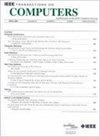RSQC: Recursive Sparse QUBO Construction for Quantum Annealing Machines
IF 3.8
2区 计算机科学
Q2 COMPUTER SCIENCE, HARDWARE & ARCHITECTURE
引用次数: 0
Abstract
Quantum annealing algorithms have shown commercial potential in solving some instances of combinatorial optimization problems. However, existing mapping for general optimization problems into a compatible format for quantum annealing yields dense topology and complicated weighting, which limits the size of solvable problems on practical quantum annealing machines. To address this issue, we propose a novel mapping framework with three new techniques. First, to address the issue from general constraints, we introduce a recursive methodology to map constraints into interconnected Boolean gates and small algebraic cliques, which yields sparse topology and hardware-friendly biases/interactions. Second, to better address frequently-used constraints, we introduce a specialized penalty set based on this methodology with detailed optimizations. Third, to address the issue from the objective, we reformulate the complicated objective into a single multi-bit variable and apply binary search to its range, which turns each search step into a constraint-only problem. Compared with the state-of-the-art, experimental results and analysis over an exhaustive scan for operand bit-widths from 1 to 64 show that: (1) the growth order of the number of physical qubits with regard to operand bit-widths is reduced from量子退火机器的递归稀疏QUBO构造
量子退火算法在解决组合优化问题的一些实例中显示出商业潜力。然而,现有的将一般优化问题映射到兼容量子退火格式的方法产生了密集的拓扑结构和复杂的加权,这限制了实际量子退火机上可解问题的大小。为了解决这个问题,我们提出了一个新的映射框架与三种新技术。首先,为了解决一般约束的问题,我们引入了递归方法将约束映射到相互连接的布尔门和小代数团,从而产生稀疏拓扑和硬件友好的偏差/交互。其次,为了更好地处理经常使用的约束,我们在此方法的基础上引入了一个专门的惩罚集,并进行了详细的优化。第三,为了从目标上解决问题,我们将复杂的目标重新表述为一个单一的多位变量,并对其范围进行二进制搜索,将每个搜索步骤变成一个约束问题。与最先进的技术相比,实验结果和对操作数位宽从1到64的穷极扫描的分析表明:(1)物理量子比特的数量相对于操作数位宽的增长顺序从$O(w^{2})$减少到$O(w)$,而在最好的情况下,数量减少了$10^{-1}$;(2)偏差/相互作用的动态范围从$O(2^{2w})$减小到$ \lt 32$;(3)在最佳情况下,图次嵌入运行时间减少了10^{-2}$。对于同样的优化问题,我们的框架降低了对物理量子比特数量和机器精度的要求,缩短了从问题到机器的时间。
本文章由计算机程序翻译,如有差异,请以英文原文为准。
求助全文
约1分钟内获得全文
求助全文
来源期刊

IEEE Transactions on Computers
工程技术-工程:电子与电气
CiteScore
6.60
自引率
5.40%
发文量
199
审稿时长
6.0 months
期刊介绍:
The IEEE Transactions on Computers is a monthly publication with a wide distribution to researchers, developers, technical managers, and educators in the computer field. It publishes papers on research in areas of current interest to the readers. These areas include, but are not limited to, the following: a) computer organizations and architectures; b) operating systems, software systems, and communication protocols; c) real-time systems and embedded systems; d) digital devices, computer components, and interconnection networks; e) specification, design, prototyping, and testing methods and tools; f) performance, fault tolerance, reliability, security, and testability; g) case studies and experimental and theoretical evaluations; and h) new and important applications and trends.
 求助内容:
求助内容: 应助结果提醒方式:
应助结果提醒方式:


